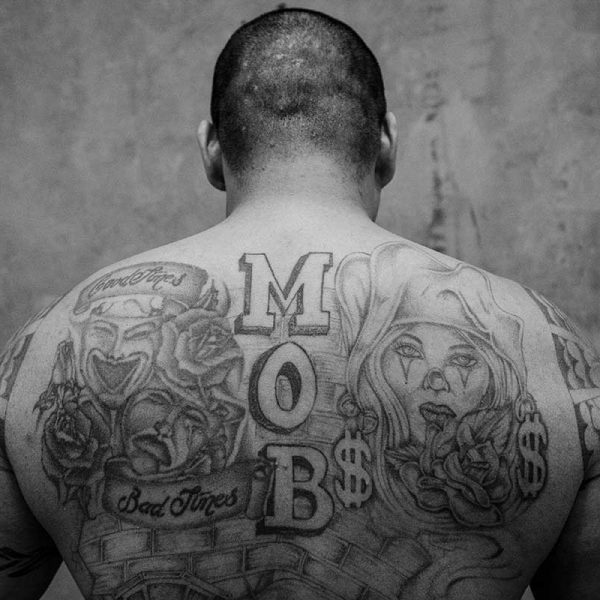Prison Tattoos: Unveiling Designs and Their Deep Meanings

Prison tattoos are not just ink on skin; they are a complex language that communicates a person's journey, rank, and affiliations within the clandestine subculture of incarceration. These tattoos carry profound meanings, often hidden from the uninitiated, and serve as permanent markers of identity, loyalty, and personal history. Understanding prison tattoos provides insight not only into the criminal world but also into human behavior, social hierarchies, and the art of storytelling through body art.
The Art of Communication Through Tattoos

Prison environments, known for their severe limitations on freedom and personal expression, lead inmates to develop sophisticated non-verbal communication methods. Tattoos are one of the most visible and permanent forms of this expression. Here's how they communicate:
- Personal Identity: Each tattoo can tell a story, from personal experiences to spiritual beliefs.
- Gang Affiliation: Tattoos often serve as identifiers of gang membership or rank within the gang.
- Reputation: They can show a prisoner's standing, either as a leader or someone with significant stories or criminal history.
- Resistance: Sometimes, tattoos are a form of defiance against the system or an expression of their disdain for authority.
Types of Prison Tattoos and Their Meanings

1. The Web and Spider

This tattoo often signifies a person trapped in their life due to drug addiction, crime, or the prison system itself. The spider might represent the person’s ability to escape or climb out of their situation.
- Web: Imprisonment, trapped life
- Spider: Transformation, survival, escape

2. The Teardrop

The teardrop tattoo is one of the most recognized prison tattoos, but its meaning can vary widely:
- Killing or Loss: Often indicates the wearer has killed someone or has lost a close friend or family member to violence.
- Time Served: Can also represent years spent in prison.
- Remorse: In some cases, it symbolizes repentance for past actions.
3. The Three Dots

Typically placed in a triangular formation, these dots are:
- Symbolic of “mi vida loca” (my crazy life) in Hispanic cultures, referring to the chaotic lifestyle often associated with gang life.
- Also known as “eye of the state” or “eye of the guards” in some prison contexts, signifying surveillance.
4. Prison Bars and Clock

The bars represent time spent behind prison walls, while the clock with no hands can signify:
- Time Standing Still: The feeling that time is irrelevant or stops inside prison.
- Life Sentence: Sometimes the absence of time can symbolize a life sentence, where time ceases to matter.

5. The Ace of Spades

Often seen as an ominous symbol:
- Represents death or killing.
- May indicate that the person has spent significant time in solitary confinement (the “hole” or “box”).
Table of Prison Tattoo Symbols

| Symbol | Meaning |
|---|---|
| Teardrop | Killing, loss, time served, remorse |
| Three Dots | My crazy life, under surveillance |
| Spider Web | Trapped, transformation, survival |
| Clock Without Hands | Life sentence, time irrelevant |
| Ace of Spades | Death, solitary confinement |

🚨 Note: Tattoos can have varied meanings, and interpretations might differ based on context, culture, or personal experiences of the wearer.
Cultural and Regional Differences

Prison tattoos aren’t uniform across the globe; they have cultural nuances:
- North America: Often related to gang affiliation, time served, and personal struggles.
- Russia: Known for their highly detailed and cryptic symbols, often denoting criminal caste and rank.
- Europe: Tattoos vary widely, but many incorporate political ideologies or national pride.
In closing, the narratives etched on the skin of prison inmates offer a window into their souls, reflecting their struggles, affiliations, and the harsh realities of the penal system. These tattoos serve as a silent but powerful communication method, telling stories of loss, survival, and sometimes redemption. While often judged from the outside, understanding these symbols provides a deeper appreciation for the intricate human stories they represent.
Why do prisoners get tattoos?

+
Prisons restrict personal expression, leading inmates to use tattoos to communicate identity, rank, and experiences. These tattoos serve as personal markers and community signals within the prison culture.
What is the most common prison tattoo?

+
Teardrop tattoos are among the most common, with varying meanings from different cultures and individuals, often related to loss, time served, or the act of killing.
Do all prisoners have tattoos?

+
No, not all prisoners get tattoos. The decision to tattoo oneself in prison can be influenced by individual beliefs, affiliations, or simply the desire for personal expression within a highly controlled environment.
What do three dots on the hand mean in prison?

+
Three dots on the hand, often forming a triangle, can symbolize “mi vida loca” (my crazy life) in Hispanic cultures, or they might represent the concept of being watched, known as the “eye of the guards” or “eye of the state.”
Can the meaning of a tattoo change after someone leaves prison?

+
Yes, the meanings of prison tattoos can evolve or become reinterpreted outside of the prison environment. They might signify past struggles or achievements, serve as reminders of former life, or simply become part of one’s personal history.



